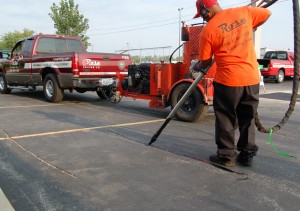Crack sealing and Lot marking: Timing is Everything
Winter is here and some of your parking lots may already be covered in snow, but that does not mean they should be buried on your checklist. In fact, winter is the perfect time to budget and plan for springtime parking lot maintenance repairs. In particular, crack sealing should be at the top of the list. Why? In simple terms, the answer is water. Wet weather throughout the winter months wreaks havoc on your pavement. Melting snow or rain seeps into cracks and softens or weakens the sub-base.

During temperature fluctuations, common in winter and spring, water that is trapped beneath the surface can widen cracks and even cause pavement heaving. If left untreated, cracks can quickly spread to adjacent areas and worsen with heavy traffic loads. Not only is this unsightly in terms of curb appeal, it is also dangerous. Crack sealing your lot is the solution and it is four times more cost effective than patching. But, the key is timing and regularity of the procedure.
Applying sealant, approximately every two years, is the most beneficial service that can be performed on a parking lot and, as you know, restaurant parking lots also require frequent re-striping. Therefore, if you have multiple restaurants in one region, your portfolio may benefit from a two-year program consisting of both crack sealing and lot marking.
Scheduling crack sealing and lot marking at the same time conserves resources because the same crews can perform both procedures and, oftentimes, complete multiple sites in one day. Furthermore, partnering with a national contractor on a program of this nature saves time in qualifying multiple bids and it reduces the cost-per-site since material can be bought in bulk. Plus, using one contractor for an entire portfolio of restaurants simplifies communication throughout the project and ensures consistent results across all locations.
However, before you begin any parking lot maintenance program, it is important to inspect your properties or partner with a reputable contractor who can perform site evaluations. When considering crack sealing, be mindful of the following six basic crack types: Reflective, Block, Edge, Slippage, Fatigue (also known as Alligator), and Joint (also known as Longitudinal). Reflective cracks reflect upward through the surface. Block cracks form a square pattern, with cracks intersecting each other at nearly right angles. Edge cracks appear only parallel to and within 18 inches of the pavement edge. Slippage cracks are usually crescent-shaped. Fatigue or Alligator cracks are a series of interconnecting cracks that develop a pattern resembling the skin of an alligator. Joint/Longitudinal cracks occur at the “joint” created during initial construction when the edges of two pavement mats are placed adjacent to one another.
With any of the aforementioned types, if cracks measure ¼-inch to 1-inch wide, they are good candidates for sealing or routing (enlargement of pavement cracks using a specialized machine). The sealing method involves cleaning the cracks using a tow-behind air compressor. Next, hot-pour material is injected into and over the uncut crack, using a hand-operated wand, and shaped into a band-aid configuration (3 to 5 inches wide and 0.125 inches thick) or a slight cap.
Configuration choice depends on factors such as crack type, traffic load, and budget. Crack widening or “routing” is strongly suggested in truck areas, but not in cracks that have already been sealed. The routing method creates a proper reservoir in the crack to which material adheres. A routing machine is used to make a channel measuring approximately ½-inch deep by ½-inch wide. Next, the channel is blown clean of dust and debris. Material is injected into the reservoir, using a wand with a special tip, and flush filled.
When crack sealing, it is important to ensure that the proper materials are used and to closely monitor the application process. Improperly sealed cracks in parking and pedestrian areas can cause several challenges. Using the wrong sealant could create bleeding of the material and subsequent tracking of the sealant onto shoes and vehicle tires. It can also result in cracking of the sealant or improper adherence to the pavement or crack itself.
Once you’ve concluded that crack sealing is appropriate for your sites, pavement markings on your parking lots should be examined. Has the paint faded or worn off completely? Abrasive friction from traffic, weather-related damage, and excess salting may be to blame. The solution is re-striping and this procedure should occur every two years or when the remaining coating has been visibly reduced to 75 percent of its original appearance.
Material and application is equally important for lot marking. Oftentimes, set-fast acrylic waterborne is the best paint to use for re-striping. The hard, smooth finish of the acrylic waterborne provides a bright color surface that holds minimal dirt and tire marks. It also ensures a clean and fresh-looking appearance over time. It must be applied, however, at temperatures above 45 degrees Fahrenheit.
At lower temperatures, oil-base alkyd paints may be used as an alternative. These paints provide a durable, inter-coat adhesion between the existing film and the new coating; however, their flat finish tends to be more susceptible to dirt and tire marks.
There are three different grades from which to choose; the highest grade has a greater pigment and resin count which provides a longer lasting and brighter finish, especially at night. Paint should be applied using an airless striping machine at a minimum of 13 mil wet film thickness to ensure high-quality lot marking. Typical drying time is 30 minutes; however, traffic should remain off the lot for at least one full hour. For best results, always consult the paint manufacturer’s recommended drying time.
A word of caution–before performing any lot marking procedure, be sure and verify that your parking lots are compliant with the Americans with Disabilities Act (ADA) standards. Lack of compliance is a liability which may result in personal injury and it is in direct violation of the law.
For example, your properties must contain a minimum number of accessible stalls based on the size of the parking lot (consult www.ada.gov for specific requirements). Additionally, there are a multitude of accessory markings to accommodate various special needs. They can be painted in a variety of colors to help distinguish them from other markings. If your property does not meet these guidelines, reconfigure the appropriate number of spaces by repainting stripes or layout new markings.
Crack sealing and lot marking are proactive procedures to help prevent further deterioration and more costly corrective measures. When batched together, these repairs save money and resources, take less time to perform, and are less disruptive than other parking lot maintenance procedures. To get started, contact your preferred parking lot maintenance contractor to discuss your options and specific plans. Ultimately, by budgeting now and planning ahead, you can maximize usable life and minimize risk for your restaurant parking lots.
This excerpt is from an article written by Rose Paving Company. First published in Facilitator Magazine in December/January 2013.




